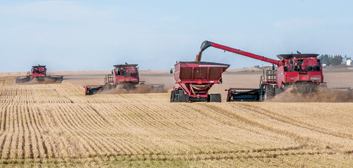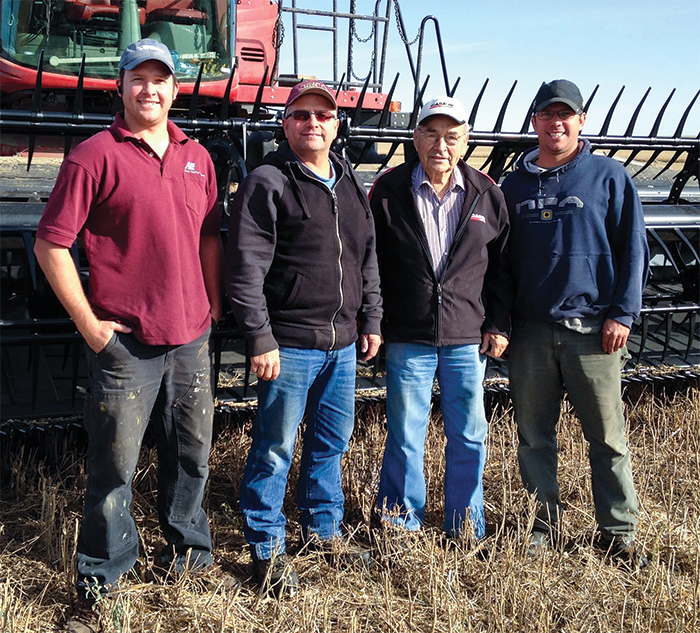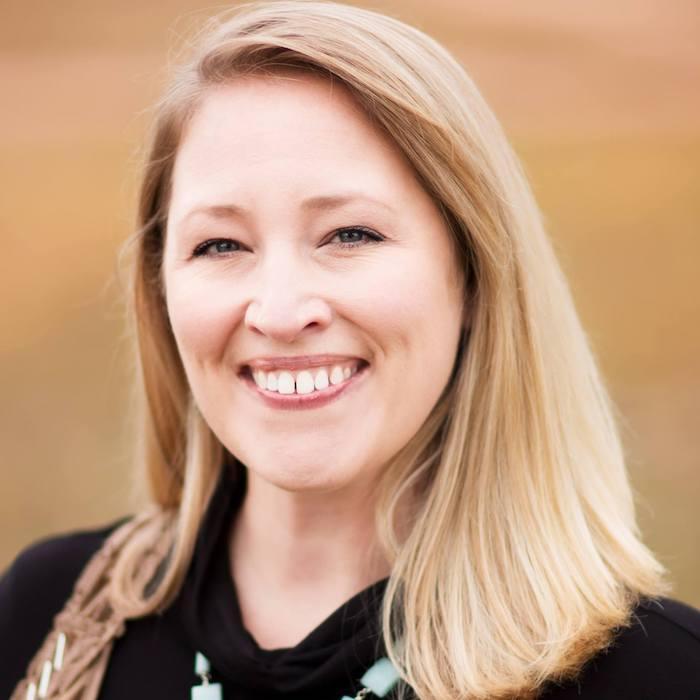Check The Specs...
Name: Spencer, Lynne, Dane, Sterling, Lianna, Gordon and Viola Hilton
Farm: Hilton Ventures Ltd.
Location: Strathmore, Alberta, Canada
Years No-Tilling: 40
Crops: Milling hard red spring wheat, malting barley and canola
Spencer: Running 10,000 acres of no-tilled hard red spring wheat, malting barley and canola in southern Alberta, Canada, is a team effort for our family. Until recently, when my parents, Gordon and Viola Hilton, exited the partnership, our farm was run by three generations.
Besides my wife, Lynne, and I, we work with my brother and sister-in-law Sterling and Lianna Hilton and my son, Dane.
Farmers here no longer talk about zero-till or direct seeding at meetings. It’s the new normal, which is largely the result of my father’s work to promote and share his experiences with the practice. As a result, the challenges we currently face aren’t the same as the previous generation.
While my father was an innovator in continuous cropping and adopting and perfecting direct seeding in the region — he was recently elected to the Alberta Agriculture Hall of Fame — my generation’s challenge is, how do we take those concepts and put them to work on a larger landscape?
My father farmed 2,500-3,000 acres with 5 people. We’re still farming with 5 people, but covering 10,000 acres. We’re looking to do more with less and take advantages of the economies of scale, which includes not splitting up the farm. Our father already took a giant step in that direction with his work in no-till.
Changing Culture
In farming, there is a culture of having a patriarchal boss, even in a multi-generational operation. We have outgrown that scenario and are becoming more businesslike.
We looked around our ownership table and thought, if one person tries to run everything they’re going to burn out. There was enough work and information to navigate for each of us to start specializing as managers. And we each fit our own niche nicely.
It’s especially beneficial to have both genders well represented, as Lynne and Lianna both play an active part in farm management. Women inherently see things differently and that alternate perspective is invaluable to our success.

|

|
| RESIDUE WORRIES. Now that their chaff and straw spreaders can be adjusted from the cab, the Hiltons can make sure they’re spreading residue across the width of the header, despite constantly changing conditions across southern Alberta and frequent time crunches. | |
Lynne and I had both focused on agronomy in our college years, so the agronomics of the operation naturally fell to us. Sterling studied accounting in college and was the obvious choice to handle grain marketing and the role of financial advisor. My oldest son, Dane, received his heavy-duty-mechanic ticket while working in the oil fields. He takes care of maintenance, repair and equipment recommendations.
Each of us researches and keeps up on our own respective areas and brings our suggestions to the team, where major decisions are checked and balanced by everyone. This has a clear impact on our operation.
Every farm manager does an internal balance, weighing pros and cons of each purchase, each management decision. But there’s always a bias in the area you specifically like. We’re able to overcome that bias thanks to our management strategy.
As agronomists, Lynne and I would love to see some more crop diversity in our operation. We’ve looked at rotating in pulse crops and covers. But our number cruncher, Sterling, argues we aren’t making any money on that rotation crop.
On the flip side, canola is our most profitable crop. If Sterling had his way that’s all we would grow, which has been tried in some parts of Alberta, but is not sustainable. So, we compromise on a reasonable rotation, and continue to look for higher value opportunities in a lower risk rotation.
Working Together
Much like we are learning to work together as a team, my father recognized early on that he had to partner with nature.
Gordon: Agriculture will always be a challenge. You have to consider nature as your partner and work within the environment of your area.
My grandfather, a tailor from London, came to Alberta in 1910 to become a farmer. Two generations later in 1964, Viola and I had an opportunity to buy a 1,400-acre farm with land, machinery and a 30-head cowherd. I immediately started cropping every acre to wheat, malting barley and canola with no summer fallow.
Spencer: In 1964, going to continuous cropping was a big change. Common wisdom was at least one-third of your acres should be allowed to rest alternating years.
I was just a child at the time, but Dad soon noted that there wasn’t much yield drag the first couple years, especially when making full use of fertilizer and herbicides.
After a period of time we started to grow better crops. Soil organic matter was increasing and soil biology was becoming more active thanks to always having roots in the soil instead of unnatural fallow. I think this made it easier for him to go ahead and start direct seeding.
Gordon: My interest in direct seeding started in 1966. I tried it out on a half section of cropland my grandfather homesteaded. It was classed as a No. 4 sandy loam. One high, sandy knoll had blown right out to the fence line during the 1930s and Dad always had me farm around it.
Today, thanks to years of no-till, I’m able to farm that knoll. I even talked the county into returning the topsoil from the fence line back to the knoll when they widen the road soon. This time, with no-till practices, that soil will stay put.
I believed in no-till pretty much from the beginning and played a leading role in helping the industry to modify equipment for no-tilling. I worked with Ray Dyken of Victory Equipment to adapt air seeder technology, which was in its infancy at the time, so it could handle all seed and fertility requirements in one pass through heavy, undisturbed stubble from the previous year. I met with farmers and also with the government to promote the concept.
Spencer: Dad initially modified equipment for direct seeding and only no-tilled a portion of the farm, since that was all he could manage at the time with his current setup and steep learning curve.
The big change for our operation came about in 1980 when he purchased a dedicated zero-till drill. He bought a Pioneer Yielder no-till drill out of the Palouse region of Washington. It was a big, heavy no-till disc drill and it was set up so Dad could place fertilizer precisely near the row at seeding, something he felt was necessary for no-till success.
Fertility Bull’s-Eye
Precise fertilizer application is something we still focus on. Long gone are the days when we randomly applied fertilizer across the landscape. When you broadcast fertilizer you’re giving the same advantage to a weed as you are to the crop.
| "This system lets me spray more consistently and accurately over wider ranges of application rates without changing nozzles…" |
We seed all of our crops with a Case IH Precision Hoe 800 air hoe drill. It’s 70 feet wide, set up for 10-inch spacing and is maneuvered precisely in the field with Trimble RTK guidance.
On each 10-inch row we place the majority of our nitrogen for the year. We use anhydrous ammonia, placed 1 inch to the side and 1¼ inch deeper than the seed. We also put a little phosphorus and potash in with the seed as a starter because we plant into cold early-spring soils.
The opener on the drill is a very narrow shank opener, about ½-inch wide. There is a wing that comes off the side and cuts a little deeper. The primary shank cuts the deeper path for the fertilizer while the smaller wing delivers the seed. It’s a very low-disturbance system.
We’re putting the fertilizer in close proximity to the seed so we can take maximum advantage of that fertilizer and limit its availability to weeds that might pop up in row middles.
Our setup is an air-seeder tank that holds our seed and dry starter fertilizer, then the 70-foot air drill, and finally the anhydrous ammonia cart. If I can get one machine to do everything, as long as it’s doing it properly, that’s going to save me time and cost.
In Our Depth
Careful depth control and singulation is a common topic for corn and soybean producers, but maybe not as talked about when it comes to small-grain production. For us, depth control is a critical part of our success in no-till — especially with canola.
Canola has a very small seed that is sensitive to depth. With a traditional drill, some seeds may be placed ½ inch deep, which is ideal, while others are over 1½ inches deep.
Canola can’t be planted deep because it needs to get out of the ground quickly. The faster it emerges, the better chance it has to fight off disease and insects, which results in a larger density of stronger plants.
Recognizing this need for precision depth control is one of several reasons we chose our current drill. Each opener on the Precision 800 has its own gauge wheel. That means it’s able to put each seed across the 70-foot drill in the ground at a fairly precise depth no matter what conditions each unit is facing.
Whether it’s canola, wheat or barley, placing seeds more accurately results in more uniform emergence, a better-quality crop and consistency across the field so that the whole crop is at the same stage for herbicide and fungicide applications and harvest.
Malters, especially, have very tight requirements for moisture, and they want the crop very dry. If we have the whole crop at roughly the same maturity we can swath all the malting barley and let it dry down in the field for 4 days before picking it up. That is a better time management for us than waiting 14 days for it to dry down in the field otherwise. That time frame would stretch even further if we had parts of the field at different maturities.
Diligent Applicators
Our sprayer is one of the most important machines on our farm, one in which we have invested considerably.
For us, optimizing applications of herbicides, fungicides and nutrients is all about timing, which is as much of an art as a science, it seems. We stay on top of weeds. Eliminating them creates a much better potential yield for our crop.
We have a 120-foot Case IH Patriot sprayer with all the bells and whistles. It has an on-board weather reporting system, auto-steer, auto shutoffs and the newest Capstan PinPoint nozzle-by-nozzle spray system.
We have one of the first PinPoint systems in western Canada and we’re very happy with it. This system turns nozzles on and off very quickly in cycles, and allows you to spray more consistently and accurately over wider ranges of application rates without changing nozzles.
We can dramatically change droplet size for sensitive borders and efficacy, and change flow rates without changing ground speed or nozzles. It’s an investment in technology for us that made our spraying system more efficient, effective and fast.
Which brings me back to timing. I want to get on top of weeds as fast as possible. With this equipment I’m able to get in the field quickly and cover a lot of acres.
Weeds are more susceptible to herbicides in their early growth stages. When they’re small and growing, I’m able to cut my application rates back to the low end of the recommended rate, a 20-25% savings. That means less chemical in the environment, it’s cheaper for me and I still get effective control.

|
| EVEN KEEL. Openers on the Hiltons’ 70-foot Precision 800 drill are spaced at 10 inches to help glide through residue at seeding. Each opener has its own gauge wheel for accurate depth control, a necessity for small-seeded canola. |
The key is execution. You have to have the equipment and the help to get out and spray from 5 a.m. to 10 p.m. for a week straight. It’s not always easy to find people to do that, but at least we have the equipment. That’s definitely something we picked up from Dad: To look at technology and, even if it’s expensive, jump on it if there’s enough of an advantage. That’s what he did with no-till and no-till equipment.
Threading the Needle
Another recent technology investment was our Trimble RTK guidance system. Managing residue with our crops is always an issue and has directed many of our equipment and agronomic decisions.
For instance, one reason we switched to Case IH combines was their easily adjustable straw and chaff spreaders. Spreading residue evenly is essential. We used to buy attachments to spread our residue, but in our most recent Case IH combines, you can adjust the spreader from the cab.
It takes a lot of discipline to stop a combine and adjust a spreader as moisture and weather conditions change throughout the day. Some adjustments only last 3 hours. But overlapping residue, or not spreading residue wide enough, can cause major issues down the line. Now that we can do it from the cab we’re doing it right from an agronomic and efficiency standpoint.
Residue also led us to our 10-inch drill spacing. We need wide spacing to accommodate the volumes of residue in our no-till system. Old tillage-based systems used seeding widths of 6 or 7½ inches. We found a compromise between the usual 12-inch and 7½-inch rows and went with 10-inch rows. This gives us better residue clearance, but research indicates no yield drag in our geography from that spacing.
To further avoid residue issues, we’re using our new RTK guidance system to plant precisely between the rows from the previous year. We planted with TrueGuide RTK in 2014, creating our grid, and will split the rows in 2015. With this system we’ll leave almost all of our residue intact and firmly rooted in the soil to catch snow, provide cover to the new seedlings and block weeds.
Equipment and accuracy are all we have left to worry about due to our father’s years of dedication to no-till. He really paved the path for us, building quality soils and teaching us to invest strategically in technology and share our knowledge. We’ve got a great foundation on which to build.








Post a comment
Report Abusive Comment